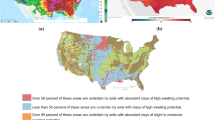Abstract
This paper reviews the analyses of several slope failures in Japan associated with clay seams and assesses the significance of ground water level. Constant-volume shear box tests were used to obtain the strength parameters. The research considered the significance of capillary forces in the clay mass in the development of a laboratory-established cohesion. It was concluded that the laboratory-obtained apparent cohesion may not be applicable in actual site conditions and that a more realistic value can be obtained using submerged/saturated samples in the constant-volume direct shear test. The practical implications of this are demonstrated with a review of the Guinsaugon rockslide, South Leyte, Philippines.
Résumé
Cet article revue les analyses de plusieurs ruptures des talus au Japon associé aux filon-couches argileux et évalue l’importance du niveau de la nappe phréatique. Les essais de la boîte du cisaillement du volume constant ont été utilisés pour obtenir les paramètres de la résistance au cisaillement du sol. L’étude a considéré significativement les forces capillaires dans la masse d’argile dans le développement d’une cohésion au laboratoire. Il a été conclu que la cohésion apparente obtenue à partir du laboratoire ne peut pas être applicable dans les cas réels et qu’une valeur plus réaliste peut être obtenue en utilisant des échantillons submergeés/satureés dans l’essai de boîte de cisaillement directe du volume constant. Les implications pratiques de celui-ci sont démontrées avec un rapport sur le glissement de la roche de Guisaugon dans le sud de Leyte (Philippines).

















































Similar content being viewed by others
References
Catane SG, Cabria HB, Tomarong CP, Saturay RM, Zarco MAH, Pioquinto WC (2006a) Extremely rapid rock slide-debris avalanche at St. Bernard, Southern Leyte, Philippines (in Japanese). Tsuchi to Kiso 54(5):33–34
Catane SG, Cabria HB, Tomarong CP, Saturay RM, Zarco MAH, Pioquinto WC (2006b) Catastrophic rockslide-debris avalanche at St. Bernard, Southern Leyte, Philippines. Landslides 4(1):305–319
Catane SG, Cabria HB, Zarco MAH, Saturay RM, Mirasol-Robert AA (2008) The 17 February 2006 Guinsaugon rock slide-debris avalanche, Southern Leyte, Philippines: deposit characteristics and failure mechanism. Bull Eng Geol Environ 67(3):305–320
Evans SG, Guthrie RH, Roberts NJ, Bishop NF (2007) The disastrous 17 February 2006 rockslide-debris avalanche on Leyte Island, Philippines: a catastrophic landslide in tropical mountain terrain. Nat Hazards Earth Syst Sci 7:89–101
Guthrie RH, Evan SG, Catane SG, Zarco MAH, Saturay RM (2009) The 17 February rock slide-debris avalanche at Guinsaugon Philippines: a synthesis. Bull Eng Geo Environ 68:201–213
Henkel DJ (1960) The relationships between the effective stresses and water content in saturated clays. Geotechnique 10:41–54
Henkel DJ (1961) Slide movements on an inclined clay layer in the Avon Gorge, Bristol. In: Proceedings of the 5th Int Conf Soil Mech Found Engng, Paris, vol 2, pp 619–624
Hoek E, Bray J (1977) Rock slope engineering, revised, 2nd edn. The Institution of Mining and Metallurgy, London, pp 199–224
Hoek E, Bray J (1981) Rock slope engineering, 3rd edn. E & FN Spon, London, pp 150–198
Hoek E, Carranza-Torres CT, Corkum B (2002) Hoek–Brown failure criterion 2002 edition. In: Proceedings of the North America Rock Mechanics Society Meeting, Toronto, pp 267–273
Ohta H, Ohmori K, Hirose T, Ohfuka N, Yamakami T (2000) Stability analyses of seven rock slope failures. In: GeoEng 2000, an international conference on geotechnical and geological engineering 2: CD-ROM: SNES0978.PDF
Orense RP, Sapuay SE (2006) Preliminary report on the 17 February 2006 Leyte Philippines landslide. Soils Found 45:685–693
Suwa H (2006) Catastrophe caused by the 17 February 2006 Southern Leyte Landslide in the Philippines (in Japanese). J Jpn Soc Nat Disaster Sci 25(1):83–97
Acknowledgments
This study was made possible by the Grant-in-Aid for Scientific Research (C) No. 20560459 from the Japan Society for the Promotion of Science (JSPS). This study was in part supported by Heiwa Nakajima Foundation and Nippon Expressway Research Institute. Helpful comments and material supply provided by Professors M.A.H. Zarco and S.G. Catane of the University of the Philippines-Diliman are gratefully appreciated.
Author information
Authors and Affiliations
Corresponding author
Rights and permissions
About this article
Cite this article
Ohta, H., Pipatpongsa, T., Heng, S. et al. Significance of saturated clays seams for the stability of rainfall-induced landslides. Bull Eng Geol Environ 69, 71–87 (2010). https://doi.org/10.1007/s10064-009-0246-6
Received:
Accepted:
Published:
Issue Date:
DOI: https://doi.org/10.1007/s10064-009-0246-6




